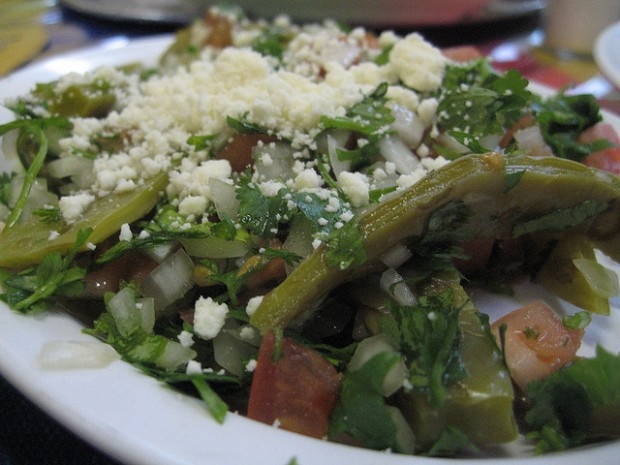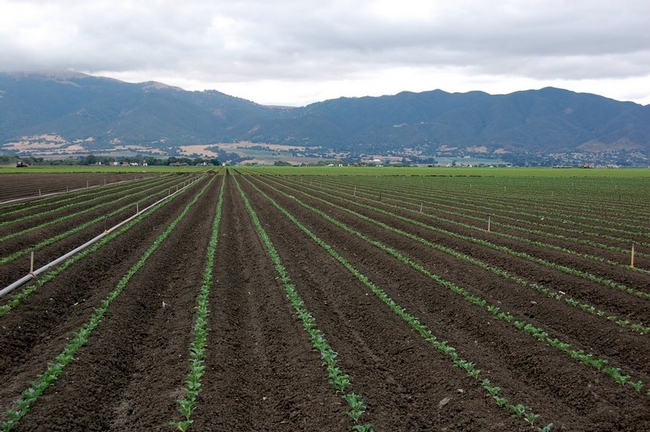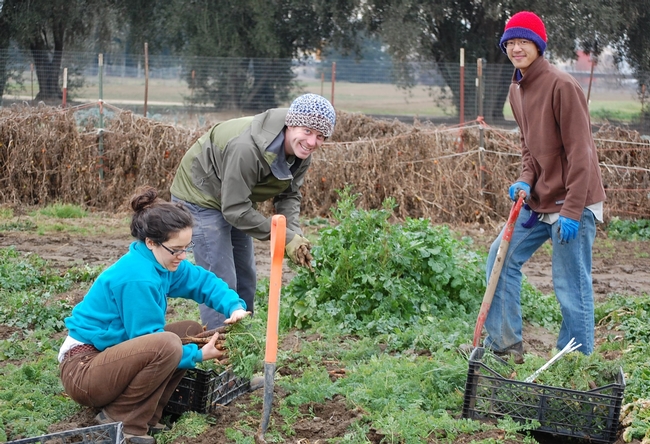UC Food Blog
UC Davis plant breeding: nurturing a rare breed
While working in Tanzania on community development projects several years ago, Iago Lowe came to a life-changing conclusion:
Food security is central to projects that make a lasting difference in people's well-being. It ensures that communities have the seeds, soil, water and environment to produce enough to eat.
However, his bachelor's degree in physics and religion from Dartmouth College did not adequately prepare him to spearhead those kinds of projects.
To address that gap in his ability to "make some small difference in the world," Lowe started doctoral studies at UC Davis in 2007 in plant breeding and genetics.
"There are so many needs in developing nations — for schools, roads, water, other infrastructure — but when the money and people leave, so often the projects die," said Lowe, who completed his Ph.D. in Plant Breeding and Genetics at UC Davis in 2011. "The few projects I saw that continued to thrive, that really made a tangible difference in people's lives, almost always dealt with local food security, seed systems, soil and water conservation and ecological restoration — projects that demanded a set of skills I didn't have. After studying plant breeding at UC Davis and that's no longer the case."
Lowe exemplifies a new breed of plant breeders at UC Davis. Long a global leader in plant breeding, UC Davis has been retooling its programs — offering new training, creating new curriculum, hiring new faculty (as the budget allows) and conducting world-class research to meet a growing demand for new crops and for breeders.
The new generation of scientists that those programs will produce — and their research breakthroughs — can't come soon enough for industry, government and philanthropic foundation leaders who say that a shortage of plant breeders is hampering efforts to alleviate hunger around the world. Hundreds of high-paying industry jobs for plant breeders are going unfilled.
“Plant breeding is such a vital tool for helping us deal with significant challenges in the 21st century such as food security, population increase, urbanization, and water and energy shortages," said Xingping Zhang, a watermelon breeder with the Davis-based seed company Syngenta. "Who is going to educate the plant breeders? UC Davis is in a perfect position to do so because it's a great center of science and technological inventions, located right in the heart of agricultural abundance. No place in the world offers the diversity of crops [like those] grown in California."
In another major nod to UC Davis expertise, the U.S. Department of Agriculture awarded $40 million in grants earlier in 2011 to develop climate-change-tolerant plants and new bioenergy sources. UC Davis scientists will lead two research teams from more than 50 universities in more than 20 states.
"Each of these projects features transdisciplinary, regional, integrated teams, including scientists from institutions that represent underserved populations," said Roger Beachy, director of the USDA's National Institute of Food and Agriculture, in announcing the grants at UC Davis. "This approach represents a new paradigm in how USDA science can best solve critical issues facing agriculture today."
You can read more about the history and future of plant breeding at UC Davis in this article in the UC Davis Magazine.
Learn more:
UC Davis plant breeding education
Story on UC Davis Department of Plant Sciences website
Seed Biotechnology Center videos on plant breeding
Survey identifies 19 produce candidates for a farm-to-WIC program
A new federal voucher that gives low-income women access to a range of fruits and vegetables could provide unique new marketing opportunities for California growers.
In 2009, the federal Special Supplemental Nutrition Program for Women, Infants and Children (WIC) began distributing monthly cash vouchers to low-income women with children to buy fruits and vegetables. The program reaches almost half of the infants and one-quarter of children under 5 years old in the United States.
A team of UC Cooperative Extension (UCCE) researchers and nutrition advisors has been exploring the possibility of developing a farm-to-WIC program that would link these low-income consumers with local growers. The purpose of such a program would be to increase the consumption of a wide variety of fresh produce, with a focus on locally grown produce when available.
UCCE conducted a survey of produce preferences and buying habits among WIC participants in Tulare, Alameda and Riverside counties in 2010. The full study is published in the January-March 2012 issue of California Agriculture journal.
Based on the results, the UCCE team developed a list of 19 produce items to promote in a possible new farm-to-WIC program. They are:
|
|
|
Although mustard greens and collards were not popular across all sites, the advisors gauged a potential market in Alameda County, so these were retained. Based on write-in responses, oranges were also added.
In California, which has the nation's largest WIC program, 82 local agencies serve about 1.43 million participants at 623 local centers, and WIC participants can redeem their monthly vouchers at 4,000 grocery stores statewide. About 40 percent shop at WIC-only stores, which stock and sell only WIC-authorized foods.
Stocking produce is relatively new to WIC-only stores; before rollout of new WIC food packages in October 2009, these stores were only required to stock limited amounts of fresh carrots. In the survey, most WIC participants (58 percent to 72.3 percent) responded that their preferred stores offered many choices, but fewer participants (18.5 percent to 41 percent) rated the produce quality as “excellent.” Key factors determining purchase decisions were produce quality and freshness, and nutrient value (vitamins and minerals). Cost was relatively less important, possibly because WIC participants procure the produce with the vouchers.
The list has served as a starting point for discussions with growers and WIC vendors.
“The survey showed that WIC participants were interested in purchasing fresh produce with better quality and more variety,” wrote lead author Lucia L. Kaiser, Cooperative Extension specialist in the UC Davis Department of Nutrition, and co-authors, in California Agriculture. “Some WIC participants that we surveyed said they avoided shopping at WIC-only stores in part because these interests were not met.”

A dish made with nopales (cactus pads).
Feeding a hungry planet
Agricultural innovation and technological advances have been harvested from UC Davis over the last century. As advances are achieved, our growing global population applies pressure for researchers to achieve more. California is a top world-wide producer of agricultural products, and California researchers work hard to find new and better ways to produce food.
The UC Davis College of Agricultural and Environmental Sciences (CA&ES) does much to contribute towards this effort. The recent CA&ES Outlook: Feeding a Hungry Planet highlights current research and innovations to provide agricultural producers knowledge and technology needed to make better, faster and economically sound decisions. This work is focused towards agriculture, conservation and economics. The articles are interesting and provide much food for thought.
For instance:
- Everyone needs to eat, and our global population is growing quickly. Economists have documented substantial long-term benefits of agricultural research.
- To continue feeding a growing population we have two options: increase yields on land already in production, or expand agriculture onto new land.
- UC researchers are developing “precision agriculture” methods, which use global positioning systems (GPS), geographic information systems (GIS), wireless networks, and innovative sensor technology to deliver precise amounts of water, fertilizer and pesticides to individual plants or small blocks of plants. This individualized management will save growers money and reduce the potential environmental load from excess fertilizer and pesticide use.
- Using GPS, a mechanical weeder has been developed. This will save growers money and reduce the need for herbicide use. On-campus testing has been successful and the weeder will be tested in a commercial field next year.
- Increasing biodiversity on and near the farm provides many benefits towards increased food production while increasing the sustainability of farming systems.
Learn more about these topics and many others in the Fall/Winter edition of CA&ES Outlook. To find out more about the UC Davis College of Agricultural and Environmental Sciences, or to view previous publications please visit their website.
Healthy snacks, healthy communities
A Food Blog post last week highlighted the great work of UC CalFresh, the UC Cooperative Extension nutrition education program that reaches more than 220,000 people a year, helping low-income families make healthy food choices, stretch food dollars and increase consumption of California’s agricultural products.
The University of California has an array of healthy living outreach efforts. In addition to CalFresh, one program that you might not expect involves the UC Davis School of Medicine. The Communities and Health Professionals Together program links pediatric residents with community-based organizations to identify and address health concerns.
Residents are assigned in teams to work with a grassroots, community-based organization, under the direction of a local leader or faculty member. Residents learn to identify and mobilize community assets to create, implement and evaluate projects that enhance the health and well being of local children and families. The program helps train physicians to be dedicated to their patients and their communities.
Resident Andrew Nuibe helps kids in a K-6 afterschool homework club prepare their own healthy snacks — and prevent childhood obesity.
“I encounter childhood obesity too often in my clinic, and that served as my inspiration,” Nuibe said. “As a child, I really enjoyed cooking with my parents. I wanted to share that enthusiasm and plant the seeds for a genuine interest in healthy food.”

UC Davis medical resident Andrew Nuibe helps kids in an afterschool club prepare healthy snacks.
More young people see future in farming
The USDA is gearing up for the 2012 Census of Agriculture, the complete count it makes every five years of U.S. farms and ranches and the people who operate them. The agricultural census provides a fascinating look at farming demographics: How old are they? Where do they live? What do they grow?
Most experts believe the census will show a trend towards the green – not just green as in sustainable, local and small-scale - but also green as in greenhorn. It seems more people from non-farming families are seeking farming careers. (You can read an Associated Press story on the topic here.)
That is especially good news in California, where the current average age of a farmer is nearly 60. Farming is a $37.5 billion business in California employing 800,000 people and providing 12 percent of the nation’s agricultural exports. With the world population forecast to grow from 7 billion to 9 billion by 2050, the demand for California’s food production will continue to grow.
Will California’s farmers be able to meet that need? The UC Davis Department of Plant Sciences is helping by providing cutting-edge research and educating a whole new crop of young people eager to take on the back-breaking work of farming the land.
“We’re definitely seeing an increased interest in farming among students,” says Crop Physiology Professor Ted DeJong, a faculty adviser for the department’s Horticultural and Agronomy Graduate Group, a popular major for students interested in farming and other aspects of agriculture. Indeed, student enrollment in horticulture and agronomy has increased from 53 in fall 2008 to 92 in fall 2011.
“Yes, I do think more young people are interested in farming,” said Gina Garland, who received her master's degree in horticultural and agronomy from UC Davis last spring. “Food is so important and it’s not very secure right now, with climate change and all. Many of us are interested in trying to find ways to make farming work in our changing environment.”
Garland is now working with AmeriCorps and a non-profit group in Albuquerque, N.M., farming and helping others farm. She might not become a farmer herself, choosing, perhaps, to seek a Ph.D. (hopefully, she says, at UC Davis), conducting research to help others farm more profitably and sustainably.
Meanwhile, at the UC Davis Agriculture Sustainability Institute Student Farm, young people are hoeing weeds, harvesting carrots and learning the joys and challenges of farming.
“It’s good to know where your food comes from,” says Eric Lynn, and undergraduate plant sciences student. “I think that’s what attracts a lot of us to farming.”
The high cost of farmland in California makes it tough for young people to enter the business, as noted in this recent story in the Western Farm Press. But many are finding ways to make farming pay by producing vegetables for sale at local restaurants, for example, or marketing their produce online. From urban roof-top gardening to using the latest in conservation agricultural practice, a new, younger breed of farmer is heeding the call. You can read more about that in this recent story on sfgate.com.
Also, have you heard about the Center for Land-Based Learning? Located in Winters, just west of campus, this non-profit is dedicated to creating the next generation of farmers and teaching California’s youth about the importance of agriculture and watershed conservation. You can learn more at: http://landbasedlearning.org/






